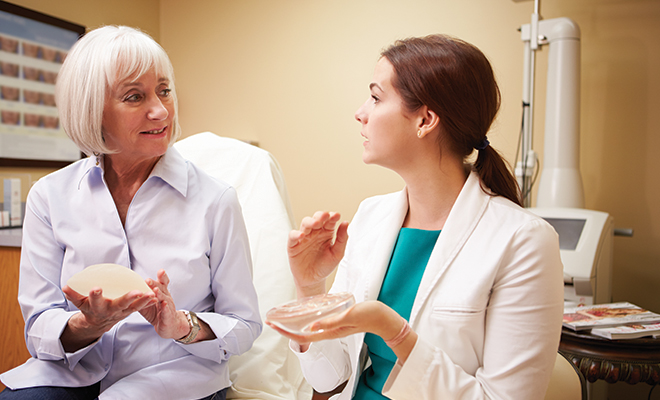
Breast Surgery, Recovery and Reconstruction
Women in the United States have a 12 percent chance of developing breast cancer, one of the more common cancer diagnoses. While breast cancer has declined over the past 25 years, women diagnosed with breast cancer are faced with many decisions.
The first decision is choosing treatment. Surgical options range from lumpectomy, which targets removal of a tumor and conserves breast tissue, to mastectomy, removal of the entire affected breast and some muscle tissue. Another option is double mastectomy. Some women with cancer in one breast opt to have both breasts surgically removed, even if the second breast is healthy, as a precaution to avoid future breast cancer. Treatment may also involve radiation and chemotherapy, both before and after surgery.
Along with treatment, women must deal with the psychological aspects of breast surgery. Some women consider whether or not to have reconstruction surgery while others do not. For some women, the decision is easy; one round of surgery and treatment is enough, and they don’t want the risks associated with additional surgeries for reconstruction. If so, they may be content with their post-surgery body as it is, or opt to use prosthetics that fit into a bra.
But women have options if they desire reconstructive surgery. Some may choose reconstruction for aesthetic reasons in order to reshape their bodies. Other women may require reconstruction surgery to relieve back pain or posture problems after a mastectomy.
The decision to have reconstructive surgery is complex. It’s possible to start reconstruction at the time of the initial breast surgery, or opt to have reconstructive surgery at a later date. There may be multiple stages of surgery; a woman with large breasts may choose reconstruction surgery accompanied by breast reduction surgery on the other breast.
Decisions about cancer surgery and treatment, as well as further surgery for reconstruction, can be daunting. It’s a lot to take on, mentally, physically and emotionally. It may help to break down options and the risks associated with each one. As with any surgery, breast reconstruction has risks and possible complications. Patients must understand that the final reconstruction will not look, or feel, like natural breasts.
Reconstruction may involve artificial implants, or use skin and tissues grafted from the patient. Both methods reconstruct the appearance of a breast, and both methods may require more than one surgical procedure. For people who require multiple surgeries, the costs and time involved may be prohibitive. Decisions will be dictated by insurance coverage as patients must pay for any procedures not covered by insurance. In addition, the time involved in reconstruction can affect your work and family life. Breast reconstruction is considered major surgery, and may require two months or more to recover before resuming normal activities. Stitches and drainage tubes may mean that assistance will be needed for post-surgical home care.
One final decision about the appearance of the breast after cancer involves whether or not to recreate the appearance of a nipple and areola. Choices for this involve using surgery together with tattoos—traditional, 3D or 4D.
With a traditional tattoo, the nipple is reconstructed by aestheticians in a plastic surgeon’s office. A high-frequency probe is used to push pigment into the skin, using dermabrasion to create the appearance of a nipple and areola, the more-pigmented skin around the nipple. Using the traditional method means that the color of the tattoo may fade over time, and may require additional maintenance sessions.
With 3D tattoos, an oscillating needle delivers pigment into the skin. This creates a picture-like tattoo that has the appearance of a real nipple. With this technique, the color is less likely to fade.
4D reconstruction involves surgery that builds a three-dimensional nipple using flesh, followed by sessions with a tattoo artist who applies pigment to create the appearance of a nipple and areola.
Whether women opt for no reconstruction surgery or full reconstruction surgery, they may choose to have an artistic tattoo. Their ink might range from an elaborate full-torso tattoo to a design on their reconstructed breasts. This choice is permanent, and it may seem extreme, but it can also represent a turning point that celebrates cancer survival. ■
Sources: breastcenter.com, breastcancer.org, medicalnewstoday.com and nytimes.com.
Choices
If you or a loved one face decisions after a breast cancer diagnosis, here are a few things to remember.
• If you explore reconstructive surgery options, consider costs, possible complications and recovery time.
• Educate yourself on complications; for example, artificial implants have a lower rate of surgical complications than using your own body tissue.
• Talk with women who have made this decision. Research and get referrals.
• If you opt for tattoo therapy, allow time for your body to heal from surgery first, and talk with your doctor to assess any risk factors.
• Take the time you need to make the choice that is best for you.







